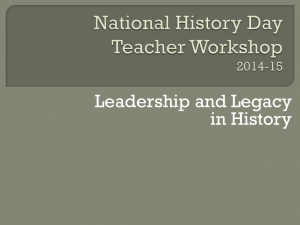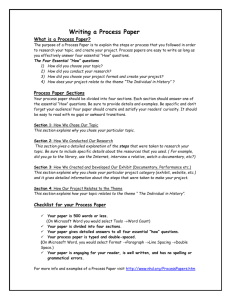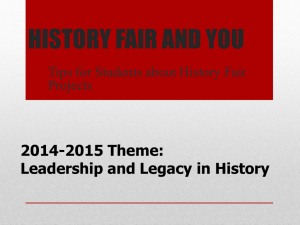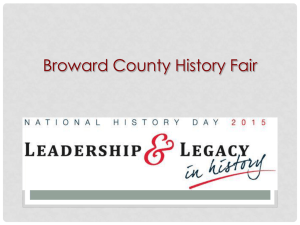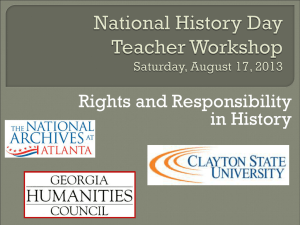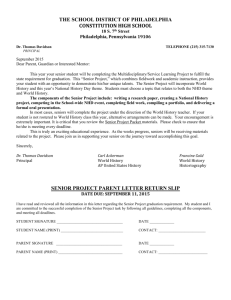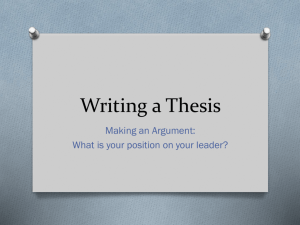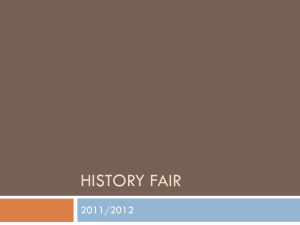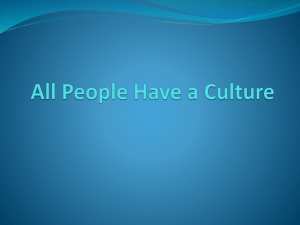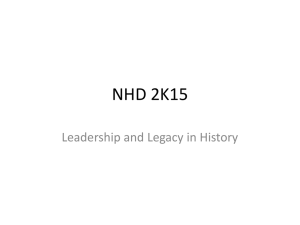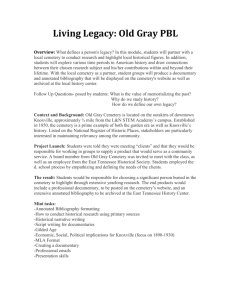National History Day PowerPoint
advertisement
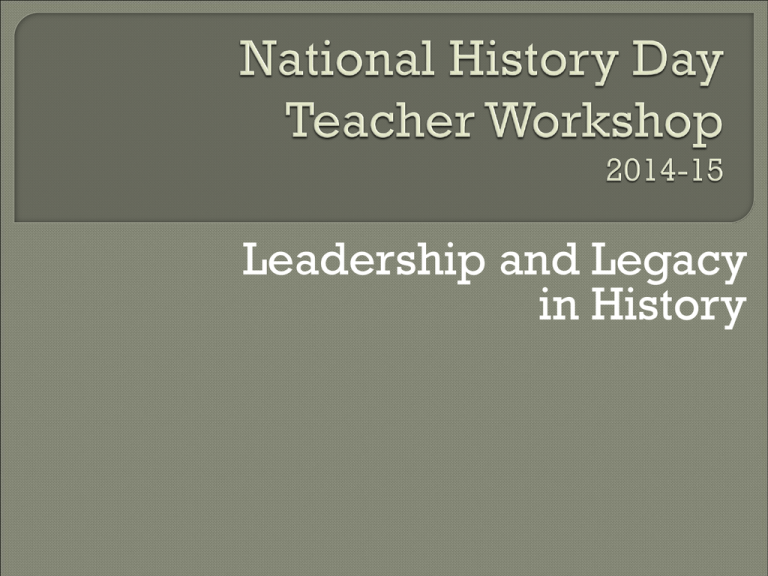
Leadership and Legacy in History Theme, Topics, and Thesis Students select a topic that relates to the annual theme Students research the topic using primary and secondary sources to develop a bibliography Students develop a thesis that they support with their research Students develop presentations from one of five possible categories: Exhibit, Documentary, Performance, Historical Paper, or Web Site Students can work as individuals or in groups Can be world, U.S., state, or local history topics Teachers can limit topics to specific curriculum needs Teachers Students should approve topics should do preliminary research to determine amount of sources available Theme has two parts • “Leadership” • “Legacy” • “in History” What does “In History” mean? • Topic must have historic perspective, historic effect • Highly recommend not to choose a topic that has happened in the last 15 to 25 years What is leadership and what is legacy? In broad terms, leadership is the act of leading: providing motivation, guidance or direction, usually from a position of authority. Examples of leadership can be found almost anywhere—in the military, politics, government, communities, social movements, or in fields such as science, the arts, education, religion and economics. • Legacy is what is handed down to us from our ancestors or predecessors. More broadly, legacy is what is left behind for future generations—such as ideas and accomplishments. Sometimes a legacy depends on perspective. Not all legacies are positive ones. What happens when leadership goes awry? Legacies also can be controversial. Events can lead one group of people to feel that a leader was a great and moral influence who facilitated a positive outcome, while a different group of people believe exactly the opposite. Students Should Consider • • • • Time and Place Cause and Effect Change over Time Impact and Significance Do more than just describe what happened Draw Conclusions about how the topic affected • • • • Individuals Communities Nations The World Research the historical background of your topic • What were things like before your topic occurred • How were things different after your topic occurred • Obviously any person you consider to be a leader who has left some kind of positive or negative legacy…. •John Smith – saved the Jamestown colony •John Adams – Fairness and the Boston Massacre Trial •Lord Baltimore – leadership of the Catholics in Maryland •Nathanael Greene – General George Washington’s second in command during the American Revolutionary War •Why Britain lost the American Revolution --- has a lot to do with poor leadership. •Corps of Discovery – Lewis & Clark •The Monroe Doctrine – made the United States a leader in the Western Hemisphere and then the world •Seneca Falls Convention – Women’s Rights and leadership of the Women’s suffrage movement started here. PRIMARY SOURCE SECONDARY SOURCE Primary Sources are created during the historical time period that is being studied or created by people that lived during the time period being studied. Secondary Sources are created after the historical time period being studied by people that did not live through the time period being studied. These can include letters, autobiographies, government forms and reports, photographs newspaper articles, interviews, etc. These can include histories, text books, biographies, journal articles, photographs, newspaper articles, interviews, etc. Students use the historical method • Preliminary research • Thesis • Research proves or disproves thesis Thesis Statement should • Address the topic • Relate to the theme • Express impact of topic http://www.nationalhistoryday.org/ http://nhd.org/ Exhibit Documentary Performance Historical Paper Website Like a Museum Exhibit Maximum Size • 6 ft. x 40 in. x 30 in. Word Limit • 500 Student-composed Words The Challenge: To Blend Graphic Design with Written Script • The 5-paragraph essay becomes the 6-part exhibit • Introduction, Background, Beginning, Middle, End, and Conclusion Background Introductory paragraph with thesis statement End of Argument Beginning of Argument Middle of Argument Conclusion Like watching the History Channel 10 Minutes or less Video, Imovie, Movie Maker, Slide presentation,etc • Can mix programs • Photo Story 3 with Movie Maker The Challenge: Blending historic images (still and moving) with narrations and background music) YouTube - National History Day Documentary Finalist 2009 A Dramatic Portrayal 10 Minutes or Less Students Write Script Find Props/Costuming Gwen & Sophie – Tesla vs. Edison https://www.youtube. com/watch?v=DD2W dwhIYfI The Challenge: Fill up the 10 minutes with solid history and good theatrical presence YouTube - The Walker Sisters vs. The Great Smoky Mountains The Turning Point That Made America Free Forever YouTube 1,500 to 2,500 Words 6 to 10 Pages DoubleSpaced Traditional or Creative Writing National History Day Contest | Student Project Examples The Challenge: Writing to Prove a Point • Organization • Verb Tense Original productions constructed using the NHD web site editor Maximum of 1,200 Visible Words Entire site may use no more than 100MB of file space. No Outside Links: Students may not use embedded material hosted elsewhere site must be viewable in a recent version of a standard web browser The Challenge: Present Historic Content in a Blending of Category Mediums • Student will use aspects of the Historical Paper, the Exhibit, and Documentary Categories • "The Emancipation Proclamation for the Disabled" – Title • The Voting Rights Act of 1965: One Vote,One Voice. Title Annotated Bibliography • MLA or Turabian format • Divide into Primary and Secondary Sources • Annotation describes how the student used the source • With web sites, tell who put out the site in the annotation • Have students develop bibliography as they work on their project Process Paper • 500 words or less • All categories except Historical Papers • Not a historical essay • Students answer four simple questions Why they chose their topic? How they did their research? How they developed their entry? How their topic relates to the theme? Every scholarly work needs a bibliography which is a list of sources used during the research process. Tell your students which Style Manual(s) will be accepted for the assignment • Historians use Turabian, English teachers use MLA • Teach your students the required information that is necessary for the creation of bibliographical citations even though it is stated in the specific Style Manual. This information is necessary for the note taking process. • NHD bibliographies are annotated. An annotation either tells how the source was used in the final product or how it was used to bring a complete understanding of the topic. Show your students what a bibliography looks like. Author (if there is one) Title of Page Title or Owner of Site URL Publication or upload date (if there is one) Access Date Citation (example): Bates, Daisy. The Long Shadow of Little Rock. 1st ed. New York: David McKay Co. Inc., 1962. Annotation (Example): Daisy Bates was the president of the Arkansas NAACP and the one who met and listened to the students each day. This first-hand account was very important to my paper because it made me more aware of the feelings of the people involved.
